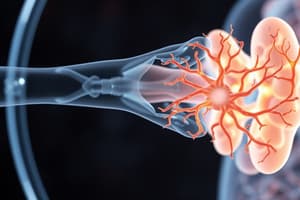Podcast
Questions and Answers
Which organisms typically have a high surface-area to volume ratio for efficient gas exchange?
Which organisms typically have a high surface-area to volume ratio for efficient gas exchange?
- Bacteria and protozoa (correct)
- Large multicellular organisms
- Plants
- Fungi
What is the primary mechanism for gas exchange across surfaces?
What is the primary mechanism for gas exchange across surfaces?
- Diffusion (correct)
- Osmosis
- Active transport
- Facilitated diffusion
In small multicellular organisms, where does gas exchange primarily occur?
In small multicellular organisms, where does gas exchange primarily occur?
- Skin or cuticle (correct)
- Lungs
- Stomata
- Gills
What is the gas exchange membrane in small unicellular organisms typically?
What is the gas exchange membrane in small unicellular organisms typically?
Why do larger organisms require an efficient system for gas exchange?
Why do larger organisms require an efficient system for gas exchange?
In which organisms is the gas exchange membrane typically the cell membrane?
In which organisms is the gas exchange membrane typically the cell membrane?
Where can a gas-permeable membrane serve as a surface for gas exchange?
Where can a gas-permeable membrane serve as a surface for gas exchange?
What is the primary organ for gas exchange in most larger organisms?
What is the primary organ for gas exchange in most larger organisms?
Which organisms are able to perform sufficient gas exchange across the skin or cuticle that surrounds their bodies?
Which organisms are able to perform sufficient gas exchange across the skin or cuticle that surrounds their bodies?
Why do most living things require an efficient system for gas exchange?
Why do most living things require an efficient system for gas exchange?
Where does gas exchange primarily occur in small multicellular organisms?
Where does gas exchange primarily occur in small multicellular organisms?
What is the gas exchange membrane in small unicellular organisms typically?
What is the gas exchange membrane in small unicellular organisms typically?
Why do larger organisms require an efficient system for gas exchange?
Why do larger organisms require an efficient system for gas exchange?
In which organisms do gases move passively by diffusion across a surface for gas exchange?
In which organisms do gases move passively by diffusion across a surface for gas exchange?
What is an example of a surface across which gas exchange might occur?
What is an example of a surface across which gas exchange might occur?
Flashcards are hidden until you start studying
Study Notes
Gas Exchange
- Organisms with high surface-area to volume ratios, such as amoebas and bacteria, have efficient gas exchange.
- The primary mechanism for gas exchange across surfaces is passive diffusion.
Small Multicellular Organisms
- Gas exchange primarily occurs on the surface of the organism.
Small Unicellular Organisms
- The gas exchange membrane is typically the cell membrane.
Larger Organisms
- Larger organisms require an efficient system for gas exchange due to their lower surface-area to volume ratios.
- The primary organ for gas exchange in most larger organisms is the lung.
Gas Exchange in Various Organisms
- Simple organisms, such as insects and amphibians, are able to perform sufficient gas exchange across the skin or cuticle that surrounds their bodies.
- Most living things require an efficient system for gas exchange because they need to take in oxygen and remove carbon dioxide to maintain cellular respiration.
Passive Diffusion
- In simple organisms, gases move passively by diffusion across a surface for gas exchange.
- Examples of surfaces across which gas exchange might occur include the skin, cuticle, or lungs.
Studying That Suits You
Use AI to generate personalized quizzes and flashcards to suit your learning preferences.




